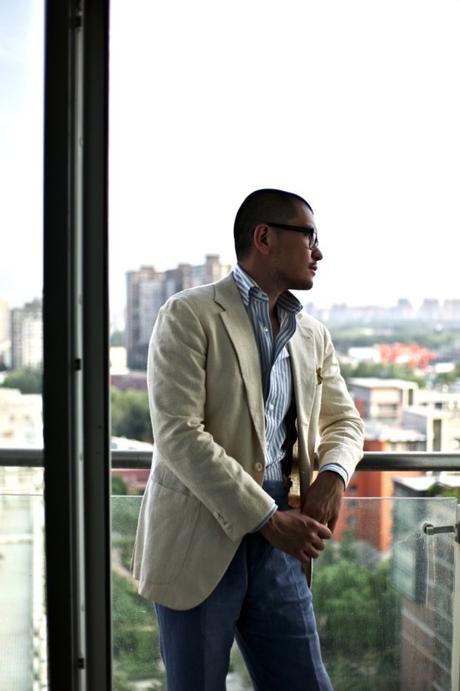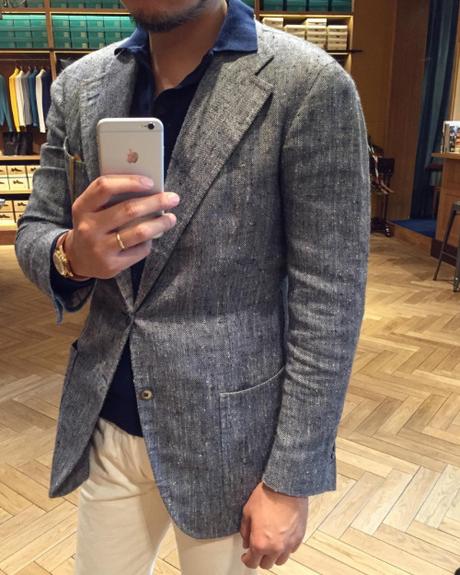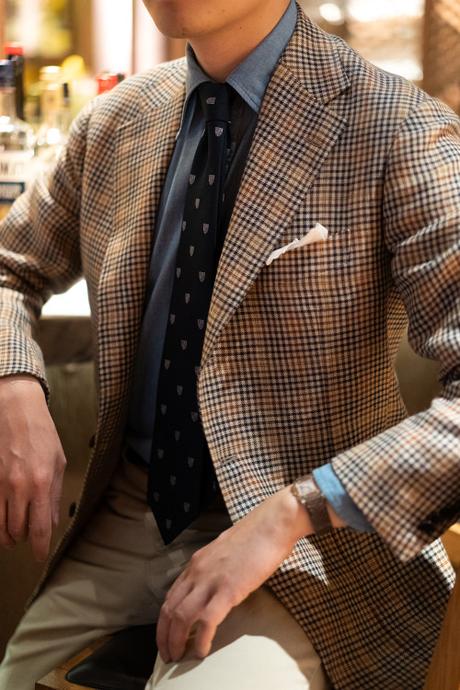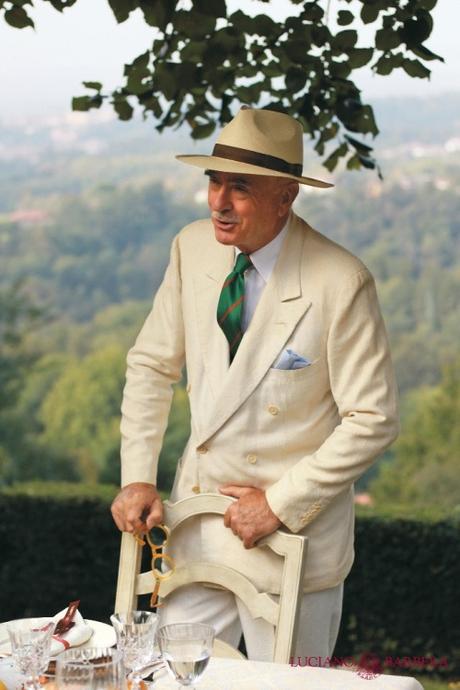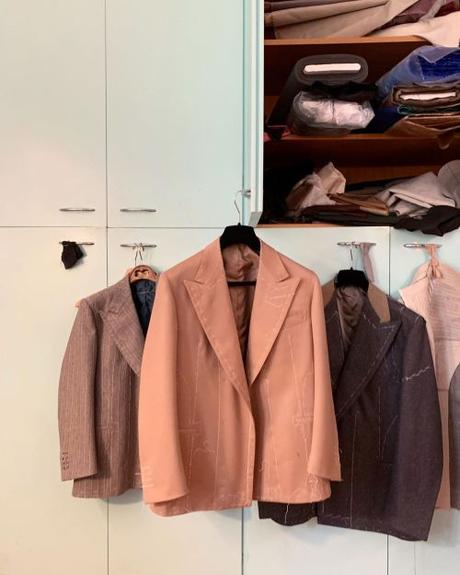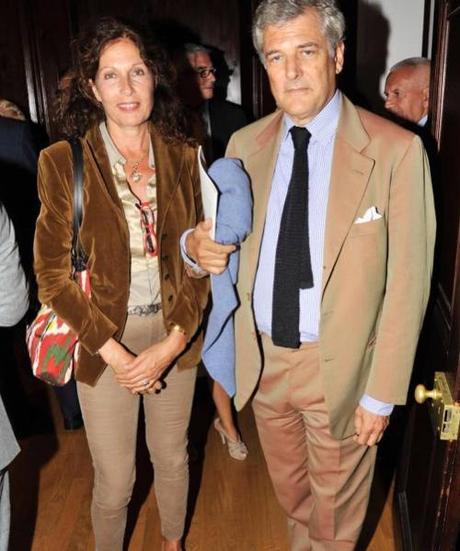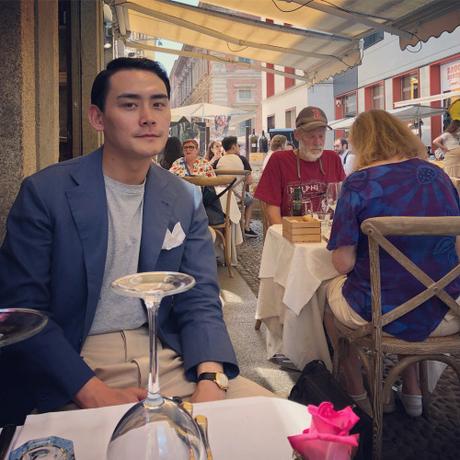
Reginald Jeeves is a fictional, dry mannered valet in a series of comedic short stories by PG Wodehouse. He serves at the behest of a charmingly clueless man-child named Bertie Wooster, a wealthy, idle Londoner who’s the very definition of Baudelaire’s dandy (“The wealthy man, who, blasé though he may be, has no occupation in life but to chase along the highway of happiness”). Wooster’s immense wealth allows him to indulge every whim and fantasy, including matters involving his wardrobe, which he views purely through the lens of personal expression and sartorial originality. He wears grape-purple socks and green Alpine hats decorated with pink feathers, often to the chagrin of the more conservatively dressed Jeeves, who tries to steer him towards better decisions.
In the short story “Jeeves in the Springtime,” Wooster wakes up and asks his valet if his new mauve shirts have arrived. Jeeves confirms they did, but he sent them back because they would not “have become him.” “Well, I must say I thought fairly highly of those shirtings, but I bowed to superior knowledge,” Wooster silently reflects. Nevertheless, Wooster springs out of bed and heads to the park to do his pastoral dances, bringing with him his whangee, his yellowest of shoes, and an old green Homburg. You can almost sense Jeeves inclining his head gravely. “In the spring, Jeeves, a livelier iris gleams upon the burnished dove,” the young master’s voice cheesed. “So I have been informed, sir,” his valet dryly replied.
I thought about these stories recently as I was flipping through swatch books at an I Sarti Italiani trunk show. In the fall and winter months, it’s much easier to choose a tasteful tweed or corduroy sport coat. Fall materials are often conservative by nature. The colors are cooler and easier to wear, and even the boldest plaids are blunted by the fact that they’re expressed on fuzzy woolens, rather than hard-finished worsteds. But come springtime, it can be a challenge to find something beyond your basic tropical wools. When spring is in the air, it’s easy to swept up by the romance of a brightly colored, bold patterned linen or silk-blend. But most warm-weather fabrics are questionable, perhaps even Wooster-like.

So this past week, I chatted with Greg Lellouche of No Man Walks Alone (a sponsor on this site), Mark Cho of The Armoury, and George Wang of BRIO to see what they look for in spring/summer tailoring. Since they advise men on cloth and style, I figured they’re in a unique position of being able to say where people should turn for a spring/summer wardrobe. Here are the basics and not-so-basics of how to find the warm-weather counterparts to your nubby Shetland tweeds and cloudy woolen flannels. Think of this advice as Jeeves’ kind, guiding hand, leading you to better choices.
THE BASICS
Let’s start with the basics. For men who wear tailored clothing, a solid-colored, navy sport coat will always be the workhorse in your wardrobe. This is something you can wear to business-casual offices, weekend brunches, fancy dinner parties, Mother’s Day celebrations, and when you travel. As a color, navy goes with everything. You can wear a navy sport coat with gray flannel trousers and a simple tie, or dress it down with a chambray shirt and blue jeans. When worn without accessories, a navy sport coat is the least self-conscious tailored jacket. As my friend Pete at Put This On once put it, no one questions the navy sport coat.
Hopsack and serge are the two most common fabrics for navy sport coats. One is a plain weave; the other a twill. Most men will wind up with a mid-weight sport coat they can wear year-round, but if you live in a hot and humid climate, you may want something lighter and more breathable. “The problem with lightweight fabrics,” says Mark at The Armory, “is that you can lose a lot of texture. This season, we have a navy sport coat made with a deep twill, which gives this more visual interest when worn. Alternatively, fine monochromatic patterns, such as a glen check, can be a great way to visually enhance a thin cloth.”
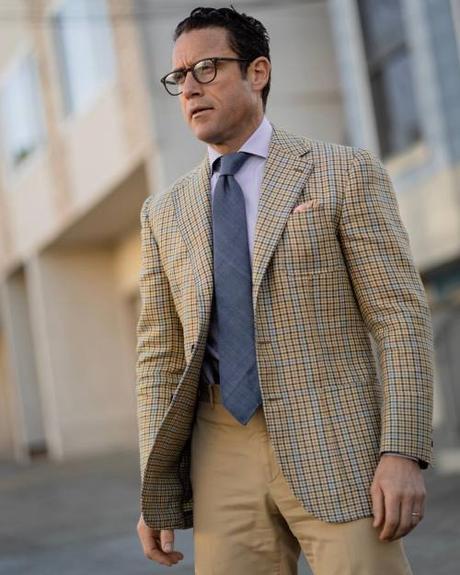
Greg of No Man Walks Alone solves this same problem by recommending his customers Mock Leno, which is a gauzy wool fabric that vaguely resembles the texture of pique cotton. As summer-ready sport coat, it has more texture than your basic tropical wools, but is just as breathable and can be worn in the same conservative settings. I recently ordered a navy Mock Leno sport coat from Sartoria Solito and am surprised by how much the texture makes a difference.
For spring/summer business suits, a wool-mohair blend will have a bit of sheen that looks nice during the summertime, while also being lightweight, comfortable, and allowing for a sharp crease. Minnis Fresco is also popular among men who are passionate about bespoke tailoring. However, it’s a bit scratchy, which requires the trousers to be lined. I have a navy Fresco suit made with patch pockets, which I sometimes break up into suit separates. Some people, however, rightly think that a patch pocketed suit in a dark worsted fabric doesn’t make any sense, as it’s too casual for formal environments (I think most people don’t notice). For a softer alternative, Greg recommends Drapers’ Ascot book, where you can find 2-ply 8oz and 4-ply 12oz worsteds. Like Fresco, Draper’s 2- and 4-ply worsteds have a crisp hand and sharp finish, but they’re softer and springier. “The four-ply worsteds in light- and mid-gray also make for wonderful trousers,” Mark adds
THE ADVANCED
Once you have a dark suit and navy sport coat that you can comfortably wear in the spring and summer months, consider your range of other earth tones. “I tend to think of light brown as a summer color, whereas dark brown is more fall/winter,” says Mark. “Oatmeal shades are perfect. Pale greens ranging from olive to sage green also work well.” Greg says he likes colors such as tobacco brown, dark brown, sandy beige, sage green, and dark green for informal suits. “For summer sport coats, stick to colors such as navy or sandy beige, or something like a rust-colored check,” he adds. “I’ve seen some good looking green sport coats, but it’s tricky finding the right shade.”
During the colder months, you can wear any number of patterns ranging from houndstooth to district checks. In the backroom of Huntsman, you can even find wild tweeds in disorientating plaids and strange colors. But in the summertime, worsteds replace woolens because they don’t have the same fuzzy nap, which allows them to wear cooler. The trade-off is in how the pattern gets expressed. Ever notice that chalk stripes are easier to wear than pinstripes? That’s because the lines are fuzzier and thus more discrete. On something such as a hard-finished linen, a pattern can be very loud.

If you want to wear a patterned sport coat in the springtime, consider something that’s colloquially referred to as a “faux tweed” or worsted tweed. Faux tweeds have the kind of district check you’d expect on a traditional tweed, but none of the prickly texture. They’re a citified version of country cloth, a springtime alternative to a winter jacketing. Indeed, some people don’t like them because they’re neither fish nor fowl, but they’re also perfect for those days that feel the same. Wear them on warm days when you’re not yet ready to give up on an autumn look. “Fox Air, Marling & Evans, and Abraham Moon are really good for gun checks,” advises Greg.
In the summertime, when you can see the morning heat rising off the asphalt like ghosts of summers past, there’s also something special about wearing a silk-blend jacket. “I won’t debate the justification for wearing silk in summer,” says George of BRIO, “because wearing it in any climate is the same as wearing sunglasses indoors or at night. You don’t do it for functional reasons.” Mark says he likes pure silk and silk-blend jackets this time of year because they have a bit of sheen. “I think patterned summer jackets look good when they have a bit of sheen, whereas fall/winter jackets are typically matte.” Some of my favorite warm-weather sport coats are made from wool-silk-linen. They have a wonderfully chunky texture, dry hand, and crisp finish. Wool in the summertime tends to be a bit finer and smoother, but with a bit of linen and silk mixed in, it can look as nubby as your favorite fall tweeds.
A little higher up on the specialty scale are linen and cotton suits, which are often bandied about as essential summer suitings, but I think are a bit more particular. Some years ago, I bought a tobacco linen suit because I thought I could wear the jacket alone as suit separates. But over time, I’ve found linen’s rumpled texture doesn’t always look right with smooth trousers. Mark says he’s gotten around this with cream linen. “I have a cream linen suit from Liverano, but I wear the jacket as a sport coat more than anything,” he says. “As a color, cream is already a bit odd by itself, which makes me feel less concerned about the matching between a rumpled jacket and pressed trousers. Whereas, I would be more concerned if it were a navy linen sport coat and gray trousers.”

I’m also excited to wear a taupe cotton suit this summer, which I recently commissioned from I Sarti Italiani. Some men are skeptical of cotton suits because they don’t have the same spring-back quality as wool, which makes them feel a bit stiff. They also tend to wear warmer than linen because they’re not as breathable, which makes them better suited for spring and fall. In dark colors, such as navy or chocolate brown, cotton will show its age easily as it fades. But I’m reminded of what Michael Hill at Drake’s once told me when I asked him what’s his favorite suit:
I love cotton suits for all the reasons why people hate them. They’re stiff, they crumple, the color fades. I can picture my cotton suit sitting on the end of my rail at home now. The way the sleeves curl, it looks like my arms are in them, and the sleeves will probably stay like that even after the jacket has been cleaned. If you get one in heavy drill cotton, the fabric almost molds to your body. That’s the wonderful thing about cotton suits. They’re casual and age with you, much like a good pair of jeans.
In tailoring, cotton and linen tend to work better when they come in heavier weights, such as those above 12oz. Heavier fabrics rumple more than they wrinkle, which makes them look more carefree than messy after a long day’s wear. Cotton can also benefit from having a touch of wool or elastane blended into the yarn. Wool and elastane soften the cloth, making it drape and move better. You can find good cotton-wool and cotton-elastane fabrics from Zegna.
Wool gabardine suits are also wonderful summer options, so long as you’re willing to only wear them as suits. The fabric is too slippery to work as a sport coat, although Colin Haywood at Anderson & Sheppard once told me that some men use wool gabardine for tan summer blazers. Supposedly, J. Press founder Jacobi Press bought a huge stock of English gabardine shortly before WWI, as he anticipated a trade embargo. During the war, as the civilian trade evaporated, he found himself using the gabardine for military uniforms. “At war’s end [my grandfather] was faced with a grossly unequal quantity of tweeds and flannels mixed with unlikely gabardine remainders from uniforms that were impossible to divide into suits,” recalls former J. Press president, Richard Press. “His solution was to make tweed jackets separately and accompany them with odd gray flannels and gabardine trousers. Yale customers cheered the new look, which became a uniform of choice for the tables down at Mory’s.” Today, tweed sport coats worn with gab trousers is still a classic American look.

THE VERY ADVANCED
Let’s say you already have a dark summer suit, summer-ready navy sport coat, fifteen gun club “faux tweeds,” and cotton suits with elastane mixtures ranging from 2% to 15% (in 0.1% increments). What’s next?
“I think the default choices are all pretty obvious by now, after years of blogs and Instagram posts preaching the virtues of dry, loosely woven, and often scratchy fabrics such as linen, Fresco, and silks,” says George. “So, I’m going to make a case for wearing Super 150s fabrics in the summer. First of all, when the hell else will you get to wear them? Summer is one of the few times when they’re appropriate, so why not indulge? When it’s hot, you want clothes that feel like they’ve disappeared. So a very light, stretchy, and drape-y Super 170s suit seems sensible.”
Since most super wools are too suit-y for odd jackets, George recommends going for something else if you want the same effect in a sport coat. A lightweight cloth that blends high-super wool or cashmere with silk or linen will feel cool, smooth, and slippery against the skin. By mixing in a bit of silk in the yarn, a weaver can achieve a bit of depth to the color (“a welcomed effect in the summer heat,” says George, “when colors tend to be washed out by the muggy air”). You can wear these with a short-sleeved shirt, such as a polo or tee, when temperatures soar into the 90s.
“In terms of color, I find that warm earthy colors such as brown and green don’t work that well in the heat. Instead, I prefer colors on the lower half of the color wheel, such as light blue, pink, coral, and salmon. Citrusy colors such as lemon are also great. For this summer, I’m having Sartoria Dalcuore make me a lightweight, Holland & Sherry linen suit in a very faint lemon yellow. A faded indigo mohair-linen suit made from Harrison’s cloth is also under commission with Sarto Jun. Additionally, on the cutting table with my in-house tailor is a dark blue suit made from a Super 170s Loro Piana cloth.”
Every so often, I’ll come across a patterned summer fabric that looks great as a swatch, but I’m not sure would translate well into a jacket. George recommends exercising caution. “Summer sport coats are often solid-colored to minimize their visual heft,” he tells me. “Summer is also when big, blocky colors come out. When I’m walking around in June or July, my sport coat is usually in my hand and slung over my shoulder, where it functions more like a sack to carry my phone and wallet. My jacket is only on when I’m indoors, where a strong A/C can make the climate as cool as late autumn.” Maybe the key to building a good spring/summer wardrobe is to listen to The Manhattans and dress by mood. Just be careful of becoming Bertie Wooster.
(Special thanks to Greg, Mark, and George for taking the time to chat with me for this post. Readers can keep up with all three clothiers on Instagram)
